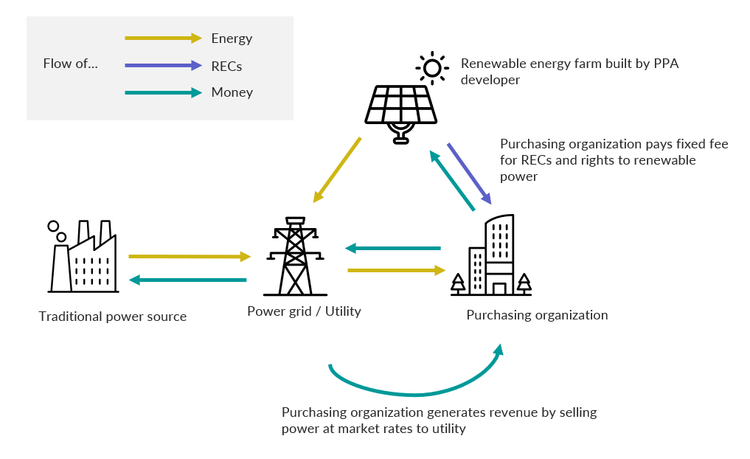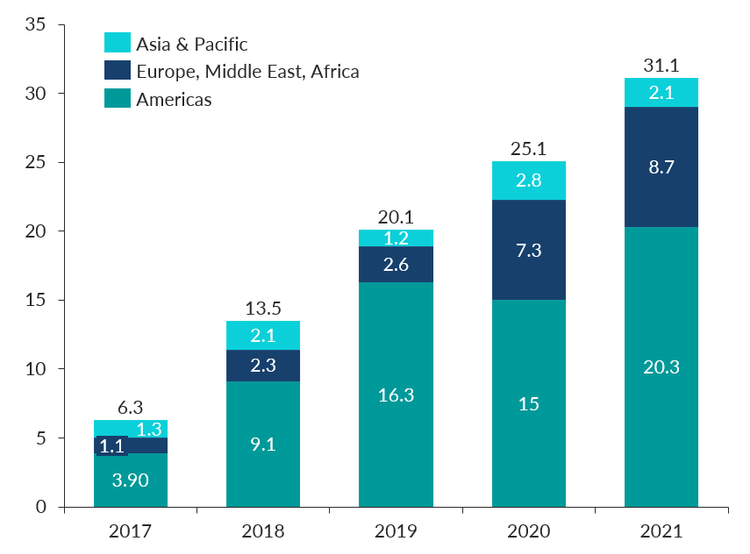Copyright © 2023 Telesto Strategy LLC, All rights reserved.
By Andrew Alesbury, Ben Vatterott & Campbell Schafer
Power Purchasing Agreements (PPAs) are an innovative way for companies to unlock Scope 2 emission reductions, but setting up a PPA is not always straightforward and requires careful up-front consideration.
As many businesses setting out on their sustainability journey soon comes to realize, there is not necessarily a neat linear correlation between the different scopes of emission and ease of implementation. While Scope 1 – the direct emissions resulting from the operations of the reporting business itself – might at first seem to be the easiest to influence (it is in the business’s direct control after all), it can be a particularly sticky thing to change, especially if the business has a large stock of capital which would need to be converted over to more sustainability-friendly alternatives. Separately, reducing Scope 3 – the indirect emissions not produced by a company itself but rather the emissions released by parties up and down its value chain – can sometimes be a surprisingly straightforward process: it can sometimes be as simple as switching from one supplier to another.
Meanwhile, Scope 2 – indirect emissions from the generation of purchased electricity usually for the use of power, steam, heating, or cooling – can be among the most challenging to target, if you are unable to leverage Power Purchasing Agreements (PPAs). Without PPAs, companies are beholden to whatever their utility provider offers. If it’s coal-generated, that’s what the company gets, end of story. The only recourse available to a business in such a circumstance is to go off the grid, installing its own renewable sources – a potentially massive and fruitless undertaking for any business with large power demands or a diffusely spread physical presence.
PPAs, however, open a different avenue for sustainability-conscious businesses looking to reduce their Scope 2 emissions without the need to make significant capital investments. PPAs, which are contracts between businesses and energy developers to purchase a pre-arranged amount of renewable energy, allow businesses to acquire renewable energy credits (RECs) which can be put forward to carbon emission goals.
How PPAs and RECs work

Source: Duke Energy (2021)
These contracts tend to be 10-20 years long and allow the purchaser to acquire renewable energy at a fixed price, thereby enabling the purchasing business to get “credit” for replacing traditional electricity with renewable alternatives and reducing its Scope 2 emissions – a massive benefit for businesses where Scope 2 emissions can be the lion’s share of all emissions. PPAs also offer businesses a great deal of flexibility. Contracts can be tailored to meet the specific needs of the business, such as the length of the contract, the amount of energy purchased, and the source of the renewable energy. This means that businesses can choose to purchase energy from a variety of sources, such as wind, solar, or hydroelectric power, depending on what is most appropriate for their needs.
PPAs can also provide a wide array of benefits beyond reducing emissions
In addition to reducing emissions, PPAs can also provide a number of other benefits, including:
- Cost savings: In some instances, PPAs can allow businesses to purchase electricity at a fixed price that is often lower than the cost of electricity from traditional fossil fuel sources.
- Brand differentiation: By purchasing renewable energy through a PPA, businesses can differentiate themselves from their competitors and demonstrate their commitment to sustainability.
- Regulatory compliance: In many jurisdictions, businesses are required to meet certain emissions reduction targets or renewable energy procurement mandates. PPAs can help businesses meet these targets and comply with regulations.
- Risk management: PPAs can help businesses manage risks associated with volatile energy prices and supply disruptions, ensuring that they have access to a stable and predictable energy supply.
Owing to their benefits, PPAs have been growing significantly in popularity in recent years. Between 2017 and 2021 alone, global demand or PPAs has grown nearly 400%, with North America leading the charge. There are also many notable examples of leading businesses embracing PPAs to reduce their Scope 2 emissions. Walmart, for example, the world’s largest retailer has committed to sourcing 50% of its energy from renewable sources by 2025. To achieve this goal, Walmart has entered into PPAs with a number of renewable energy developers, including wind and solar projects. These projects are expected to provide Walmart with over 7 billion kilowatt-hours of renewable energy annually, which is equivalent to the energy needs of over 600,000 homes.
Additional corporate PPA volumes by region, 2017-21 (additional GW added)

Source: BloombergNEF (2022)
Another example is Google, which has committed to purchasing enough renewable energy to match 100% of its energy consumption. To achieve this goal, Google has entered into a variety of PPAs, including wind and solar projects in the United States, Europe, and South America. These projects are expected to generate over 5.5 gigawatts of clean energy, which is equivalent to the energy needs of over 1 million homes.
Companies interested in PPAs, however, need to recognize that it is not as simple as calling up their utility provider and switching over the next day. Before heading down that path, we suggest that businesses ask themselves five key questions:
- Compatibility: How appropriate is a PPA for our company? What kind of PPA is best suited for our needs?
- Structuring: What are feasible Scope 2 emission targets our company can reach in 15-20 years? What PPA size is best for our company’s future needs? What deployment speed is necessary to reach these Scope 2 targets?
- People and Players: How can our company connect to reliable energy providers? Contract bidders? How will this affect existing company organization?
- Implementation: How will our company weigh the pros and cons of the contracts we receive? How much should we bid on a contract? How do we determine the best time to implement our new PPA?
Answering these questions should not be considered a trivial exercise: it requires deep technical understanding and sustainability knowhow. At Telesto, we have the capabilities and experience to help your business determine if PPAs are the right approach to achieving your sustainability ambitions and attaining your emissions reduction targets.

